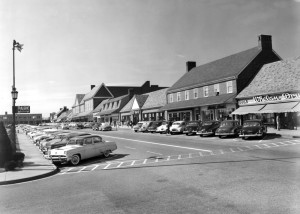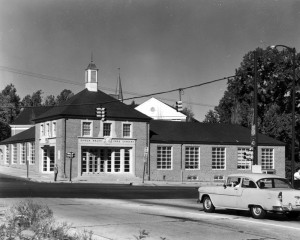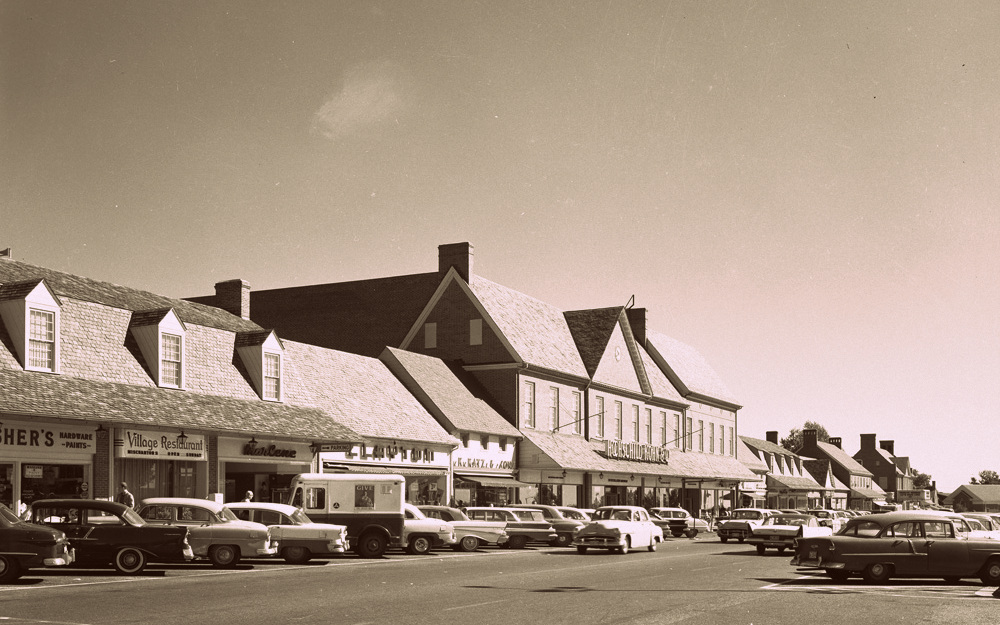Explore stories of an innovative shopping center, a treasured community library, and the famed Edmondson-Westside High School.
 In the years after WWII, Baltimore could hardly keep up with a quickly growing number of houses and people. Shoppers filled the parking lots at brand-new shopping centers. Residents fought for new schools and libraries. Capturing this story, Edmondson Village boasts landmarks from sites that date from when the area was more country than city up to landmarks from heyday of mid-century Baltimore.
In the years after WWII, Baltimore could hardly keep up with a quickly growing number of houses and people. Shoppers filled the parking lots at brand-new shopping centers. Residents fought for new schools and libraries. Capturing this story, Edmondson Village boasts landmarks from sites that date from when the area was more country than city up to landmarks from heyday of mid-century Baltimore.
Edmondson Village Shopping Center
“Small wonder that so many thousands of Baltimoreans make it a point of pride to bring out-of-town visitors to Edmondson Village, a landmark of Baltimore progress.”
Jacob and Joseph Meyerhoff, 1950

Built by developers Jacob and Joseph Meyerhoff, the Edmondson Village Shopping Center opened to huge crowds on May 7, 1947. The Baltimore Evening Sun called the project “a suburban shopping center of harmonious design, said to be unique in American city planning.” Architects Kenneth Miller and James Edmunds combined traditional Colonial Revival design with innovative features including a terraced 500-car parking lot that made the shopping center one of first designed for drivers. For decades after WWII, shoppers enjoyed over 29 shops selling everything from fur coats to auto supplies to ice cream. A bowling alley arrived in 1949 and the Hecht Company opened a store across the street in 1958. In recent decades, the Edmondson Village Shopping Center has struggled with competition from larger suburban shopping malls, but still remains an important anchor for nearby neighborhoods.
Enoch Pratt Free Library Edmondson Avenue Branch

In 1943, a group of local residents from Ten Hills and Edmondson Village came together to start a neighborhood lending library. The effort grew quickly and the organizers asked the developers of Edmondson Village Shopping Center to donate a space for the community. The Enoch Pratt Free Library took charge of the small “library station” and, with strong support from neighborhood residents, opened a small Colonial Revival branch library in 1951. Renovated between 2008 and 2010, the library remains a beloved and vital community institution today.
New Cathedral Cemetery
The Archdiocese of Baltimore established New Cathedral Cemetery on forty acres of the old “Bonnie Brae” country estate in 1869. The church spent seventeen years moving bodies and headstones from the Cathedral Cemetery (established in 1816 at Riggs and Fremont Avenues). In 1936, the church moved hundreds more from the grounds of St. Patrick’s Cemetery on Orleans Street. Well-known locals buried on the grounds include Baltimore’s first black mayor, Clarence H. ‘Du’ Burns, Sister Mary Antonio of the Oblate Sisters of Providence, and four Hall of Fame Orioles players.
Edmondson-Westside Senior High School
Famed for competitive sports teams from the 1960s through the present, Edmondson-Westside High School is an architectural landmark designed by architects Palmer, Fisher, Williams & Nes. When construction began in the late 1940s, then Edmondson Avenue High School was the first new high school built in the city since 1924. The school expanded in the early 1980s with a move into the former Hecht Company store (built in 1955 and closed in the late 1970s).
Homes & Sanitariums
Before the 1919 annexation that transferred Edmondson Village from Baltimore County to Baltimore City, the area was seen as a rural retreat perfect for a picturesque cottage or a quiet hospital. Mansions and sanitariums that once dotted the countryside have largely been lost to fire or demolition but two landmarks still survive.
Uplands Episcopal Home
This 42-room Victorian mansion started as the summer home of Mary Frick Jacobs, a famed Baltimore socialite and philanthropist, who left the building to the Episcopal Church after her death 1936. From 1952 to 1986, the estate served as the Uplands Home for Church Women. In the early 1990s, New Psalmist Baptist Church acquired the property and incorporated the historic building into a new church. The building now stands at the center of the recently developed Uplands community.
Gundry Sanitarium
Dr. Alfred T. Gundry served as the medical superintendent at nearby Spring Grove Hospital from 1878 to 1891 where he was a pioneer in ending the use of mechanical restraints on psychiatric patients. In the late 1800s, he established the Gundry Sanitarium on his family farm and the Gundry family continued to operate the facility up through 1990.
“Splendidly located, retired and accessible to Baltimore, surrounded by 28 acres of beautiful grounds. Buildings modern and well arranged. Every facility for treatment and classification. Under the medical management of Dr. Alfred T. Gundry.”
1903 Advertisement

